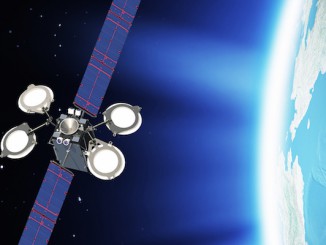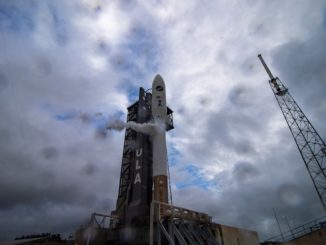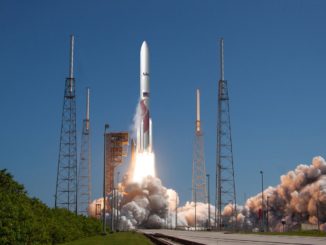
A robotic U.S. Air Force space plane is set to land in California as soon as this week after a secretive 22-month flight hundreds of miles above Earth.
Built by Boeing Co., the X-37B space plane will touch down on a runway at Vandenberg Air Force Base, Calif., the Air Force said Friday, but officials did not say when the spacecraft was scheduled to land.
The return will end the mysterious X-37B space plane program’s third mission, which passed 671 days in orbit Monday. Its activities in space have been kept secret by the Air Force, but some analysts speculate the winged spaceship could test next-generation surveillance, communications and intelligence-gathering instruments, deploy small satellites, or demonstrate new materials for use in future military programs.
The program’s cost is also kept under wraps by the Pentagon.
Resembling a miniature space shuttle, the 29-foot-long X-37B space plane takes off on top of a conventional launch vehicle, deploys solar panels to generate electricity in orbit, then returns to Earth like a glider for an automated landing on a runway.
“Preparations for the third landing of the X-37B, the Air Force’s unmanned, reusable space plane, are underway at Vandenberg Air Force Base,” the Air Force said Friday in a press release. “The exact landing date and time will depend on technical and weather considerations.”
The spaceship’s return could come as soon as Tuesday. The Air Force has warned pilots to stay away from Vandenberg’s three-mile-long runway from 8 a.m. to 5 p.m. local time (1500-0000 GMT; 11 a.m.-8 p.m. EDT) Tuesday.
“Team Vandenberg stands ready to implement safe landing operations for the X-37B Orbital Test Vehicle, the third time for this unique mission,” said Col. Keith Baits, commander of the Air Force’s 30th Space Wing.
The X-37B space plane launched on the Orbital Test Vehicle 3, or OTV 3, mission from Cape Canaveral on Dec. 11, 2012, aboard a United Launch Alliance Atlas 5 rocket.
The flight shattered the X-37B’s officially stated orbital lifetime of 270 days, but Air Force officials offered no explanation for the mission’s long duration.
The Air Force’s two earlier X-37B missions landed in June 2012 and December 2010.
The space plane set to conclude the X-37B program’s third mission spent 224 days in orbit in 2010. Air Force and Boeing engineers refurbished the spacecraft and launched it again two years after it landed.
Experienced observers who track objects in space noted the X-37B space plane recently lowered its orbit to about 275 kilometers, or 170 miles. The two previous X-37B missions conducted similar maneuvers just before landing.
“OTV 3 recently lowered its altitude to roughly match that of its predecessors prior to their landings, which led some us to speculate that it may land in the near future,” said Ted Molczan, a respected Canadian amateur satellite tracker who coordinates observations from worldwide observers.
Unlike the two earlier missions, the X-37B stayed at approximately the same altitude for most of its 22 months in space. The craft began lowering its orbit some time this spring.
When Air Force officials select a landing opportunity, ground controllers will send commands for the mini-shuttle to retract its solar panel, close its cargo bay doors and fire a rocket engine for a burn to drop out of orbit.
The X-37B will fall from space and plummet back into the atmosphere, weathering blazing temperatures with a shield of thermal blankets and ceramic tiles. The lifting body space plane will be flying on autopilot and touch down on Vandenberg’s runway at nearly 300 mph.
With a wingspan of nearly 15 feet and a height of 9.5 feet, the X-37B is about one-fourth the size of a space shuttle orbiter. Its cargo hold is about the size of a pickup truck bed.
According to a Boeing fact sheet, the X-37B weighs about 11,000 pounds fully fueled for launch. It is made of composite structures, and its heat shield is made reusable insulation blankets and silica thermal protection tiles tougher than the tiles flown on the space shuttle.
Fitted with wings lined with heat-resistant ceramic tiles at the leading edge, the X-37B is designed to withstand fiery-hot temperatures of re-entry as it approaches Vandenberg from the west. A GPS navigation system will guide the automated spaceship toward the runway, and a three-piece landing gear will lower from the craft’s belly just before touchdown.
The Air Force has plans to move the X-37B program’s home base to NASA’s Kennedy Space Center in Florida.
Boeing is overseeing modifications to two decommissioned space shuttle hangers at KSC, aiming to complete the work by December, NASA said in a statement last week.
An Air Force spokesperson said in July that the X-37B’s fourth mission could return to Earth at the space center’s Shuttle Landing Facility and tow over to one of the hangers for refurbishment for another launch from nearby Cape Canaveral Air Force Station.



